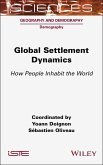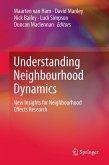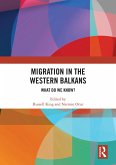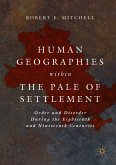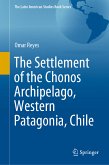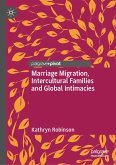Global Settlement Dynamics (eBook, PDF)
How People Inhabit the World
Redaktion: Doignon, Yoann; Oliveau, Sebastien
142,99 €
142,99 €
inkl. MwSt.
Sofort per Download lieferbar

0 °P sammeln
142,99 €
Als Download kaufen

142,99 €
inkl. MwSt.
Sofort per Download lieferbar

0 °P sammeln
Jetzt verschenken
Alle Infos zum eBook verschenken
142,99 €
inkl. MwSt.
Sofort per Download lieferbar
Alle Infos zum eBook verschenken

0 °P sammeln
Global Settlement Dynamics (eBook, PDF)
How People Inhabit the World
Redaktion: Doignon, Yoann; Oliveau, Sebastien
- Format: PDF
- Merkliste
- Auf die Merkliste
- Bewerten Bewerten
- Teilen
- Produkt teilen
- Produkterinnerung
- Produkterinnerung

Bitte loggen Sie sich zunächst in Ihr Kundenkonto ein oder registrieren Sie sich bei
bücher.de, um das eBook-Abo tolino select nutzen zu können.
Hier können Sie sich einloggen
Hier können Sie sich einloggen
Sie sind bereits eingeloggt. Klicken Sie auf 2. tolino select Abo, um fortzufahren.

Bitte loggen Sie sich zunächst in Ihr Kundenkonto ein oder registrieren Sie sich bei bücher.de, um das eBook-Abo tolino select nutzen zu können.
There are currently over eight billion people on Earth: how did we arrive at the current distribution of humans on the planet? What shape is it taking, and how will it evolve?
This book proposes an original answer to this, which is based on the explicit desire to place settlement at the heart of its questioning, by varying the level of analysis from global to local. After recalling how humans colonized the entire planet, this book presents their current distribution, which is predominantly urban.
Population dynamics (birth rate, death rate and migration) are driving changes - including…mehr
- Geräte: PC
- mit Kopierschutz
- eBook Hilfe
- Größe: 24.53MB
Andere Kunden interessierten sich auch für
![Global Settlement Dynamics (eBook, ePUB) Global Settlement Dynamics (eBook, ePUB)]() Global Settlement Dynamics (eBook, ePUB)142,99 €
Global Settlement Dynamics (eBook, ePUB)142,99 €![Understanding Neighbourhood Dynamics (eBook, PDF) Understanding Neighbourhood Dynamics (eBook, PDF)]() Understanding Neighbourhood Dynamics (eBook, PDF)73,95 €
Understanding Neighbourhood Dynamics (eBook, PDF)73,95 €![Migration in the Western Balkans (eBook, PDF) Migration in the Western Balkans (eBook, PDF)]() Migration in the Western Balkans (eBook, PDF)43,95 €
Migration in the Western Balkans (eBook, PDF)43,95 €![Human Geographies Within the Pale of Settlement (eBook, PDF) Human Geographies Within the Pale of Settlement (eBook, PDF)]() Robert E. MitchellHuman Geographies Within the Pale of Settlement (eBook, PDF)69,95 €
Robert E. MitchellHuman Geographies Within the Pale of Settlement (eBook, PDF)69,95 €![The Settlement of the Chonos Archipelago, Western Patagonia, Chile (eBook, PDF) The Settlement of the Chonos Archipelago, Western Patagonia, Chile (eBook, PDF)]() Omar ReyesThe Settlement of the Chonos Archipelago, Western Patagonia, Chile (eBook, PDF)105,95 €
Omar ReyesThe Settlement of the Chonos Archipelago, Western Patagonia, Chile (eBook, PDF)105,95 €![Marriage Migration, Intercultural Families and Global Intimacies (eBook, PDF) Marriage Migration, Intercultural Families and Global Intimacies (eBook, PDF)]() Kathryn RobinsonMarriage Migration, Intercultural Families and Global Intimacies (eBook, PDF)32,95 €
Kathryn RobinsonMarriage Migration, Intercultural Families and Global Intimacies (eBook, PDF)32,95 €![Immigration (eBook, PDF) Immigration (eBook, PDF)]() Immigration (eBook, PDF)44,95 €
Immigration (eBook, PDF)44,95 €-
-
-
There are currently over eight billion people on Earth: how did we arrive at the current distribution of humans on the planet? What shape is it taking, and how will it evolve?
This book proposes an original answer to this, which is based on the explicit desire to place settlement at the heart of its questioning, by varying the level of analysis from global to local. After recalling how humans colonized the entire planet, this book presents their current distribution, which is predominantly urban.
Population dynamics (birth rate, death rate and migration) are driving changes - including the demographic decline of certain regions - which are presented and explained from the angle of residential mobility and international migration, as well as the impact of ongoing climate change. Global Settlement Dynamics concludes with a discussion of the future of these settlements, based on data from the United Nations, and the question of the sustainability of human settlements on Earth.
This book proposes an original answer to this, which is based on the explicit desire to place settlement at the heart of its questioning, by varying the level of analysis from global to local. After recalling how humans colonized the entire planet, this book presents their current distribution, which is predominantly urban.
Population dynamics (birth rate, death rate and migration) are driving changes - including the demographic decline of certain regions - which are presented and explained from the angle of residential mobility and international migration, as well as the impact of ongoing climate change. Global Settlement Dynamics concludes with a discussion of the future of these settlements, based on data from the United Nations, and the question of the sustainability of human settlements on Earth.
Dieser Download kann aus rechtlichen Gründen nur mit Rechnungsadresse in D ausgeliefert werden.
Produktdetails
- Produktdetails
- Verlag: Wiley-ISTE
- Seitenzahl: 262
- Erscheinungstermin: 20. November 2024
- Englisch
- ISBN-13: 9781394340576
- Artikelnr.: 72262928
- Verlag: Wiley-ISTE
- Seitenzahl: 262
- Erscheinungstermin: 20. November 2024
- Englisch
- ISBN-13: 9781394340576
- Artikelnr.: 72262928
- Herstellerkennzeichnung Die Herstellerinformationen sind derzeit nicht verfügbar.
Yoann Doignon is a researcher in population geography at the IDEES Laboratory at the CNRS in Rouen, France. He is also a research associate at the Centre for Demographic Research, UCLouvain, Belgium. Sébastien Oliveau is a lecturer, as well as a geographer and demographer at the University of Aix-Marseille, and Director of MSH Paris-Saclay, France. He is also a member of the Observatoire démographique de la Méditerranée, France.
Introduction
Sébastien Oliveau And Yoann Doignon
Chapter 1 History of World Population and Settlement 1
Pierre-Jean Thumerelle
1.1 From the primitive African cradle to world "conquest" 2
1.1.1 The approximately one hundred or two hundred thousand years before
sedentarization 2
1.1.2 Hypothetical Upper Paleolithic settlement 3
1.1.3 Agriculture, sedentarization and the first demographic revolution 4
1.2 The era of agrarian civilizations 7
1.2.1 The demographic foundation of settlement and its limits 7
1.2.2 The evolution of human population from Antiquity to the end of the
early modern period 8
1.2.3 Migration and colonization of the past 11
1.3 Demographic transition and repopulation 13
1.3.1 The European demographic revolution of the 19th century 13
1.3.2 Transfer of the European model to new countries 15
1.3.3 Transformation of the European population 16
1.4 Contemporary demographic and urban explosion and the new settlement map
19
1.4.1 Liquidation of 19th century demography and the baby boom 19
1.4.2 Years of exponential demographics 20
1.4.3 A fractured global demographic dynamic 22
1.4.4 Densification, urbanization and metropolization 26
1.5 Conclusion 30
1.6 References 30
Chapter 2 World Population Distribution Today 33
Catherine Linard And Florence De Longueville
2.1 Introduction 33
2.2 Data and methods 35
2.2.1 Counting the population 35
2.2.2 Methods for fine resolution global mapping 38
2.3 Analysis of the current world population distribution 40
2.3.1 Major settlement clusters 40
2.3.2 High contrasts 42
2.4 Factors explaining the world population distribution 49
2.5 Processes contributing to the evolution of population distribution 51
2.5.1 Natural growth 51
2.5.2 Movements within national borders 52
2.5.3 International migrations 53
2.5.4 Pioneer frontiers 53
2.6 Conclusion 54
2.7 References 54
Chapter 3 An Urban World 63
François Moriconi-Ebrard And Joan Perez
3.1 Introduction: city or urban center? 63
3.2 Deciphering the urban world from the rural world 65
3.2.1 The urban world: a development in three acts 65
3.2.2 Urban world, rural world: a loss of meaning? 67
3.2.3 Reversal of migratory dynamics 69
3.2.4 Disappearance of the political dichotomy 72
3.2.5 Metropolization and metapolization 74
3.3 Measurement and excess in the urban world 76
3.3.1 National data 77
3.3.2 Sources 80
3.3.3 Large national and continental complexes 83
3.3.4 Factors 88
3.4 Contemporary forms and dynamics of urban settlement 90
3.4.1 Redevelopment, sprawl, new cities and neighborhoods, verticalization
90
3.4.2 Urban decay, deurbanization, shrinkage and perforation 94
3.5 Conclusion 97
3.6 References 99
Chapter 4 Population Decline in a Growing World 105
Yoann Doignon
4.1 Introduction 105
4.2 Population decline: theoretical elements 108
4.2.1 Demographic equation 108
4.2.2 Evolution of the two components of demographic dynamics 110
4.3 A granular vision of the population decline in the world 116
4.4 Case studies to identify geographic characteristics of population
decline 118
4.4.1 Decline in Japan: a population concentration in megalopolises at the
expense of other spaces 120
4.4.2. Widespread population decline: the case of three Central and Eastern
European countries (Bulgaria, Romania and Hungary) .. 123
4.4.3. France: significant population decline in a growing country 127
4.5 Conclusion: towards a retreat of the Ecumene? 130
4.6 References 132
Chapter 5 Residential Mobility and Settlement Dynamics 137
Frédéric Audard And Samuel Carpentier-Postel
5.1 Introduction 137
5.2 Residential mobility: conceptual elements 138
5.2.1 Geographical mobility typology 138
5.2.2 Socio-economic approaches 140
5.2.3 Spatial dynamics 142
5.3 Panorama of residential mobility dynamics 143
5.3.1 In the western hemisphere 144
5.3.2 Specific logics in the Global South 147
5.4 Differentiated developments 150
5.4.1 In western countries 151
5.4.2 In the Global South 152
5.5 Conclusion 153
5.6 References 155
Chapter 6 Populations in Motion: How is Global Settlement Being Redefined?
161
Philippe Venier And Sébastien Oliveau
6.1 Introduction 161
6.2 Global migration in the 21st century 162
6.2.1 A comprehensive assessment of global population stocks and flows 163
6.2.2 Major migration dynamics by continental area 165
6.3 International migration and settlement logics 179
6.3.1 Difficulty in measuring the impact on settlement 179
6.3.2 Naturalizations, family reunification and regularizations 181
6.4 Conclusion 183
6.5 References 185
Chapter 7 Migration, Environmental and Climate Change 187
Marion Borderon
7.1 Introduction 187
7.2 Understanding the complex and multidimensional relationships of the
link between environmental change and migration 189
7.2.1 A summary of the renewed interest in the environment in studying
migration 189
7.2.2 How many of these migrants are there? The risky gamble of climate
migration estimates and projections 192
7.2.3 A consensual conceptual framework: summary of the effects of
environmental change on human migration 195
7.3. The Golden Age of empirical case studies or the pragmatic approach to
grasping the complexity of the migration-environment link 199
7.3.1 Fitting puzzle pieces together 199
7.3.2 Providing the tools to study migrations in their environment 202
7.3.3 Missing pieces of the puzzle 204
7.4 Conclusion 206
7.5 References 208
Chapter 8 Population Projections on a Global Scale 213
Élise Lévêque, Quentin Godoye And Dieynaba Ndour
8.1 United Nations' projections 214
8.2 Unequal population evolution 218
8.2.1 Towards a new world equilibrium in 2100 219
8.2.2 Unequally distributed growth and decline 224
8.3 A population distribution that fluctuates but exhibits regularities 229
8.4 Conclusion 232
8.5 References 233
Conclusion 235
Sébastien Oliveau And Yoann Doignon
List of Authors 241
Index 243
Sébastien Oliveau And Yoann Doignon
Chapter 1 History of World Population and Settlement 1
Pierre-Jean Thumerelle
1.1 From the primitive African cradle to world "conquest" 2
1.1.1 The approximately one hundred or two hundred thousand years before
sedentarization 2
1.1.2 Hypothetical Upper Paleolithic settlement 3
1.1.3 Agriculture, sedentarization and the first demographic revolution 4
1.2 The era of agrarian civilizations 7
1.2.1 The demographic foundation of settlement and its limits 7
1.2.2 The evolution of human population from Antiquity to the end of the
early modern period 8
1.2.3 Migration and colonization of the past 11
1.3 Demographic transition and repopulation 13
1.3.1 The European demographic revolution of the 19th century 13
1.3.2 Transfer of the European model to new countries 15
1.3.3 Transformation of the European population 16
1.4 Contemporary demographic and urban explosion and the new settlement map
19
1.4.1 Liquidation of 19th century demography and the baby boom 19
1.4.2 Years of exponential demographics 20
1.4.3 A fractured global demographic dynamic 22
1.4.4 Densification, urbanization and metropolization 26
1.5 Conclusion 30
1.6 References 30
Chapter 2 World Population Distribution Today 33
Catherine Linard And Florence De Longueville
2.1 Introduction 33
2.2 Data and methods 35
2.2.1 Counting the population 35
2.2.2 Methods for fine resolution global mapping 38
2.3 Analysis of the current world population distribution 40
2.3.1 Major settlement clusters 40
2.3.2 High contrasts 42
2.4 Factors explaining the world population distribution 49
2.5 Processes contributing to the evolution of population distribution 51
2.5.1 Natural growth 51
2.5.2 Movements within national borders 52
2.5.3 International migrations 53
2.5.4 Pioneer frontiers 53
2.6 Conclusion 54
2.7 References 54
Chapter 3 An Urban World 63
François Moriconi-Ebrard And Joan Perez
3.1 Introduction: city or urban center? 63
3.2 Deciphering the urban world from the rural world 65
3.2.1 The urban world: a development in three acts 65
3.2.2 Urban world, rural world: a loss of meaning? 67
3.2.3 Reversal of migratory dynamics 69
3.2.4 Disappearance of the political dichotomy 72
3.2.5 Metropolization and metapolization 74
3.3 Measurement and excess in the urban world 76
3.3.1 National data 77
3.3.2 Sources 80
3.3.3 Large national and continental complexes 83
3.3.4 Factors 88
3.4 Contemporary forms and dynamics of urban settlement 90
3.4.1 Redevelopment, sprawl, new cities and neighborhoods, verticalization
90
3.4.2 Urban decay, deurbanization, shrinkage and perforation 94
3.5 Conclusion 97
3.6 References 99
Chapter 4 Population Decline in a Growing World 105
Yoann Doignon
4.1 Introduction 105
4.2 Population decline: theoretical elements 108
4.2.1 Demographic equation 108
4.2.2 Evolution of the two components of demographic dynamics 110
4.3 A granular vision of the population decline in the world 116
4.4 Case studies to identify geographic characteristics of population
decline 118
4.4.1 Decline in Japan: a population concentration in megalopolises at the
expense of other spaces 120
4.4.2. Widespread population decline: the case of three Central and Eastern
European countries (Bulgaria, Romania and Hungary) .. 123
4.4.3. France: significant population decline in a growing country 127
4.5 Conclusion: towards a retreat of the Ecumene? 130
4.6 References 132
Chapter 5 Residential Mobility and Settlement Dynamics 137
Frédéric Audard And Samuel Carpentier-Postel
5.1 Introduction 137
5.2 Residential mobility: conceptual elements 138
5.2.1 Geographical mobility typology 138
5.2.2 Socio-economic approaches 140
5.2.3 Spatial dynamics 142
5.3 Panorama of residential mobility dynamics 143
5.3.1 In the western hemisphere 144
5.3.2 Specific logics in the Global South 147
5.4 Differentiated developments 150
5.4.1 In western countries 151
5.4.2 In the Global South 152
5.5 Conclusion 153
5.6 References 155
Chapter 6 Populations in Motion: How is Global Settlement Being Redefined?
161
Philippe Venier And Sébastien Oliveau
6.1 Introduction 161
6.2 Global migration in the 21st century 162
6.2.1 A comprehensive assessment of global population stocks and flows 163
6.2.2 Major migration dynamics by continental area 165
6.3 International migration and settlement logics 179
6.3.1 Difficulty in measuring the impact on settlement 179
6.3.2 Naturalizations, family reunification and regularizations 181
6.4 Conclusion 183
6.5 References 185
Chapter 7 Migration, Environmental and Climate Change 187
Marion Borderon
7.1 Introduction 187
7.2 Understanding the complex and multidimensional relationships of the
link between environmental change and migration 189
7.2.1 A summary of the renewed interest in the environment in studying
migration 189
7.2.2 How many of these migrants are there? The risky gamble of climate
migration estimates and projections 192
7.2.3 A consensual conceptual framework: summary of the effects of
environmental change on human migration 195
7.3. The Golden Age of empirical case studies or the pragmatic approach to
grasping the complexity of the migration-environment link 199
7.3.1 Fitting puzzle pieces together 199
7.3.2 Providing the tools to study migrations in their environment 202
7.3.3 Missing pieces of the puzzle 204
7.4 Conclusion 206
7.5 References 208
Chapter 8 Population Projections on a Global Scale 213
Élise Lévêque, Quentin Godoye And Dieynaba Ndour
8.1 United Nations' projections 214
8.2 Unequal population evolution 218
8.2.1 Towards a new world equilibrium in 2100 219
8.2.2 Unequally distributed growth and decline 224
8.3 A population distribution that fluctuates but exhibits regularities 229
8.4 Conclusion 232
8.5 References 233
Conclusion 235
Sébastien Oliveau And Yoann Doignon
List of Authors 241
Index 243
Introduction
Sébastien Oliveau And Yoann Doignon
Chapter 1 History of World Population and Settlement 1
Pierre-Jean Thumerelle
1.1 From the primitive African cradle to world "conquest" 2
1.1.1 The approximately one hundred or two hundred thousand years before
sedentarization 2
1.1.2 Hypothetical Upper Paleolithic settlement 3
1.1.3 Agriculture, sedentarization and the first demographic revolution 4
1.2 The era of agrarian civilizations 7
1.2.1 The demographic foundation of settlement and its limits 7
1.2.2 The evolution of human population from Antiquity to the end of the
early modern period 8
1.2.3 Migration and colonization of the past 11
1.3 Demographic transition and repopulation 13
1.3.1 The European demographic revolution of the 19th century 13
1.3.2 Transfer of the European model to new countries 15
1.3.3 Transformation of the European population 16
1.4 Contemporary demographic and urban explosion and the new settlement map
19
1.4.1 Liquidation of 19th century demography and the baby boom 19
1.4.2 Years of exponential demographics 20
1.4.3 A fractured global demographic dynamic 22
1.4.4 Densification, urbanization and metropolization 26
1.5 Conclusion 30
1.6 References 30
Chapter 2 World Population Distribution Today 33
Catherine Linard And Florence De Longueville
2.1 Introduction 33
2.2 Data and methods 35
2.2.1 Counting the population 35
2.2.2 Methods for fine resolution global mapping 38
2.3 Analysis of the current world population distribution 40
2.3.1 Major settlement clusters 40
2.3.2 High contrasts 42
2.4 Factors explaining the world population distribution 49
2.5 Processes contributing to the evolution of population distribution 51
2.5.1 Natural growth 51
2.5.2 Movements within national borders 52
2.5.3 International migrations 53
2.5.4 Pioneer frontiers 53
2.6 Conclusion 54
2.7 References 54
Chapter 3 An Urban World 63
François Moriconi-Ebrard And Joan Perez
3.1 Introduction: city or urban center? 63
3.2 Deciphering the urban world from the rural world 65
3.2.1 The urban world: a development in three acts 65
3.2.2 Urban world, rural world: a loss of meaning? 67
3.2.3 Reversal of migratory dynamics 69
3.2.4 Disappearance of the political dichotomy 72
3.2.5 Metropolization and metapolization 74
3.3 Measurement and excess in the urban world 76
3.3.1 National data 77
3.3.2 Sources 80
3.3.3 Large national and continental complexes 83
3.3.4 Factors 88
3.4 Contemporary forms and dynamics of urban settlement 90
3.4.1 Redevelopment, sprawl, new cities and neighborhoods, verticalization
90
3.4.2 Urban decay, deurbanization, shrinkage and perforation 94
3.5 Conclusion 97
3.6 References 99
Chapter 4 Population Decline in a Growing World 105
Yoann Doignon
4.1 Introduction 105
4.2 Population decline: theoretical elements 108
4.2.1 Demographic equation 108
4.2.2 Evolution of the two components of demographic dynamics 110
4.3 A granular vision of the population decline in the world 116
4.4 Case studies to identify geographic characteristics of population
decline 118
4.4.1 Decline in Japan: a population concentration in megalopolises at the
expense of other spaces 120
4.4.2. Widespread population decline: the case of three Central and Eastern
European countries (Bulgaria, Romania and Hungary) .. 123
4.4.3. France: significant population decline in a growing country 127
4.5 Conclusion: towards a retreat of the Ecumene? 130
4.6 References 132
Chapter 5 Residential Mobility and Settlement Dynamics 137
Frédéric Audard And Samuel Carpentier-Postel
5.1 Introduction 137
5.2 Residential mobility: conceptual elements 138
5.2.1 Geographical mobility typology 138
5.2.2 Socio-economic approaches 140
5.2.3 Spatial dynamics 142
5.3 Panorama of residential mobility dynamics 143
5.3.1 In the western hemisphere 144
5.3.2 Specific logics in the Global South 147
5.4 Differentiated developments 150
5.4.1 In western countries 151
5.4.2 In the Global South 152
5.5 Conclusion 153
5.6 References 155
Chapter 6 Populations in Motion: How is Global Settlement Being Redefined?
161
Philippe Venier And Sébastien Oliveau
6.1 Introduction 161
6.2 Global migration in the 21st century 162
6.2.1 A comprehensive assessment of global population stocks and flows 163
6.2.2 Major migration dynamics by continental area 165
6.3 International migration and settlement logics 179
6.3.1 Difficulty in measuring the impact on settlement 179
6.3.2 Naturalizations, family reunification and regularizations 181
6.4 Conclusion 183
6.5 References 185
Chapter 7 Migration, Environmental and Climate Change 187
Marion Borderon
7.1 Introduction 187
7.2 Understanding the complex and multidimensional relationships of the
link between environmental change and migration 189
7.2.1 A summary of the renewed interest in the environment in studying
migration 189
7.2.2 How many of these migrants are there? The risky gamble of climate
migration estimates and projections 192
7.2.3 A consensual conceptual framework: summary of the effects of
environmental change on human migration 195
7.3. The Golden Age of empirical case studies or the pragmatic approach to
grasping the complexity of the migration-environment link 199
7.3.1 Fitting puzzle pieces together 199
7.3.2 Providing the tools to study migrations in their environment 202
7.3.3 Missing pieces of the puzzle 204
7.4 Conclusion 206
7.5 References 208
Chapter 8 Population Projections on a Global Scale 213
Élise Lévêque, Quentin Godoye And Dieynaba Ndour
8.1 United Nations' projections 214
8.2 Unequal population evolution 218
8.2.1 Towards a new world equilibrium in 2100 219
8.2.2 Unequally distributed growth and decline 224
8.3 A population distribution that fluctuates but exhibits regularities 229
8.4 Conclusion 232
8.5 References 233
Conclusion 235
Sébastien Oliveau And Yoann Doignon
List of Authors 241
Index 243
Sébastien Oliveau And Yoann Doignon
Chapter 1 History of World Population and Settlement 1
Pierre-Jean Thumerelle
1.1 From the primitive African cradle to world "conquest" 2
1.1.1 The approximately one hundred or two hundred thousand years before
sedentarization 2
1.1.2 Hypothetical Upper Paleolithic settlement 3
1.1.3 Agriculture, sedentarization and the first demographic revolution 4
1.2 The era of agrarian civilizations 7
1.2.1 The demographic foundation of settlement and its limits 7
1.2.2 The evolution of human population from Antiquity to the end of the
early modern period 8
1.2.3 Migration and colonization of the past 11
1.3 Demographic transition and repopulation 13
1.3.1 The European demographic revolution of the 19th century 13
1.3.2 Transfer of the European model to new countries 15
1.3.3 Transformation of the European population 16
1.4 Contemporary demographic and urban explosion and the new settlement map
19
1.4.1 Liquidation of 19th century demography and the baby boom 19
1.4.2 Years of exponential demographics 20
1.4.3 A fractured global demographic dynamic 22
1.4.4 Densification, urbanization and metropolization 26
1.5 Conclusion 30
1.6 References 30
Chapter 2 World Population Distribution Today 33
Catherine Linard And Florence De Longueville
2.1 Introduction 33
2.2 Data and methods 35
2.2.1 Counting the population 35
2.2.2 Methods for fine resolution global mapping 38
2.3 Analysis of the current world population distribution 40
2.3.1 Major settlement clusters 40
2.3.2 High contrasts 42
2.4 Factors explaining the world population distribution 49
2.5 Processes contributing to the evolution of population distribution 51
2.5.1 Natural growth 51
2.5.2 Movements within national borders 52
2.5.3 International migrations 53
2.5.4 Pioneer frontiers 53
2.6 Conclusion 54
2.7 References 54
Chapter 3 An Urban World 63
François Moriconi-Ebrard And Joan Perez
3.1 Introduction: city or urban center? 63
3.2 Deciphering the urban world from the rural world 65
3.2.1 The urban world: a development in three acts 65
3.2.2 Urban world, rural world: a loss of meaning? 67
3.2.3 Reversal of migratory dynamics 69
3.2.4 Disappearance of the political dichotomy 72
3.2.5 Metropolization and metapolization 74
3.3 Measurement and excess in the urban world 76
3.3.1 National data 77
3.3.2 Sources 80
3.3.3 Large national and continental complexes 83
3.3.4 Factors 88
3.4 Contemporary forms and dynamics of urban settlement 90
3.4.1 Redevelopment, sprawl, new cities and neighborhoods, verticalization
90
3.4.2 Urban decay, deurbanization, shrinkage and perforation 94
3.5 Conclusion 97
3.6 References 99
Chapter 4 Population Decline in a Growing World 105
Yoann Doignon
4.1 Introduction 105
4.2 Population decline: theoretical elements 108
4.2.1 Demographic equation 108
4.2.2 Evolution of the two components of demographic dynamics 110
4.3 A granular vision of the population decline in the world 116
4.4 Case studies to identify geographic characteristics of population
decline 118
4.4.1 Decline in Japan: a population concentration in megalopolises at the
expense of other spaces 120
4.4.2. Widespread population decline: the case of three Central and Eastern
European countries (Bulgaria, Romania and Hungary) .. 123
4.4.3. France: significant population decline in a growing country 127
4.5 Conclusion: towards a retreat of the Ecumene? 130
4.6 References 132
Chapter 5 Residential Mobility and Settlement Dynamics 137
Frédéric Audard And Samuel Carpentier-Postel
5.1 Introduction 137
5.2 Residential mobility: conceptual elements 138
5.2.1 Geographical mobility typology 138
5.2.2 Socio-economic approaches 140
5.2.3 Spatial dynamics 142
5.3 Panorama of residential mobility dynamics 143
5.3.1 In the western hemisphere 144
5.3.2 Specific logics in the Global South 147
5.4 Differentiated developments 150
5.4.1 In western countries 151
5.4.2 In the Global South 152
5.5 Conclusion 153
5.6 References 155
Chapter 6 Populations in Motion: How is Global Settlement Being Redefined?
161
Philippe Venier And Sébastien Oliveau
6.1 Introduction 161
6.2 Global migration in the 21st century 162
6.2.1 A comprehensive assessment of global population stocks and flows 163
6.2.2 Major migration dynamics by continental area 165
6.3 International migration and settlement logics 179
6.3.1 Difficulty in measuring the impact on settlement 179
6.3.2 Naturalizations, family reunification and regularizations 181
6.4 Conclusion 183
6.5 References 185
Chapter 7 Migration, Environmental and Climate Change 187
Marion Borderon
7.1 Introduction 187
7.2 Understanding the complex and multidimensional relationships of the
link between environmental change and migration 189
7.2.1 A summary of the renewed interest in the environment in studying
migration 189
7.2.2 How many of these migrants are there? The risky gamble of climate
migration estimates and projections 192
7.2.3 A consensual conceptual framework: summary of the effects of
environmental change on human migration 195
7.3. The Golden Age of empirical case studies or the pragmatic approach to
grasping the complexity of the migration-environment link 199
7.3.1 Fitting puzzle pieces together 199
7.3.2 Providing the tools to study migrations in their environment 202
7.3.3 Missing pieces of the puzzle 204
7.4 Conclusion 206
7.5 References 208
Chapter 8 Population Projections on a Global Scale 213
Élise Lévêque, Quentin Godoye And Dieynaba Ndour
8.1 United Nations' projections 214
8.2 Unequal population evolution 218
8.2.1 Towards a new world equilibrium in 2100 219
8.2.2 Unequally distributed growth and decline 224
8.3 A population distribution that fluctuates but exhibits regularities 229
8.4 Conclusion 232
8.5 References 233
Conclusion 235
Sébastien Oliveau And Yoann Doignon
List of Authors 241
Index 243

